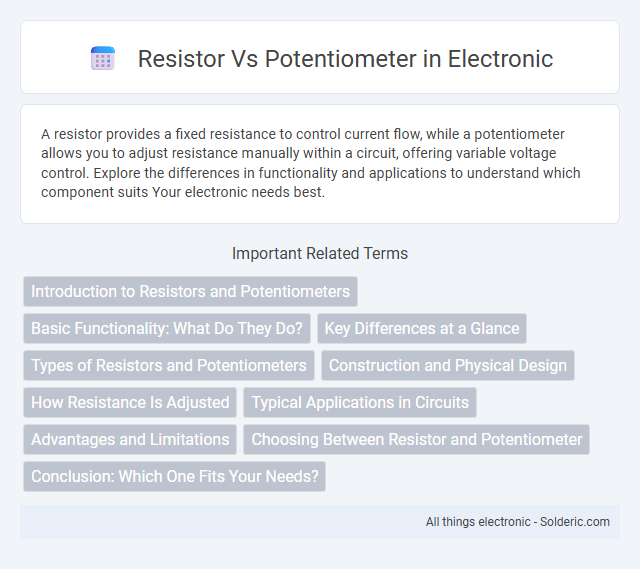A resistor provides a fixed resistance to control current flow, while a potentiometer allows you to adjust resistance manually within a circuit, offering variable voltage control. Explore the differences in functionality and applications to understand which component suits Your electronic needs best.
Comparison Table
| Feature | Resistor | Potentiometer |
|---|---|---|
| Function | Limits current, drops voltage | Adjusts voltage, varies resistance |
| Type | Fixed resistor | Variable resistor |
| Construction | Two terminals | Three terminals |
| Applications | Current control, voltage division | Volume control, tuning circuits |
| Adjustability | Non-adjustable | Adjustable resistance |
| Symbol | Simple zigzag or rectangle | Resistor with arrow |
Introduction to Resistors and Potentiometers
Resistors are fixed electrical components that limit current flow and divide voltage within a circuit, characterized by a specific resistance value measured in ohms. Potentiometers function as adjustable resistors, allowing you to vary resistance manually through a rotating or sliding contact, commonly used for controlling voltage levels or tuning circuits. Understanding the difference between resistors and potentiometers is essential for designing and troubleshooting electronic devices that require precise control over electrical signals.
Basic Functionality: What Do They Do?
Resistors regulate electrical current by providing a fixed level of resistance, ensuring stable voltage and protecting circuits from excess current. Potentiometers function as adjustable resistors, allowing users to vary resistance manually and control voltage levels dynamically in devices like volume knobs or tuning controls. Both components are essential for managing current flow, but potentiometers offer customizable resistance adjustments while resistors provide constant values.
Key Differences at a Glance
Resistors provide a fixed resistance value used to control current flow in circuits, while potentiometers offer adjustable resistance, allowing variable voltage division. Resistors are typically used for consistent performance without user interaction, whereas potentiometers enable manual tuning of electrical signals. The core distinction lies in their functionality: resistors maintain steady resistance, and potentiometers serve as dynamic, user-controlled resistive devices.
Types of Resistors and Potentiometers
Resistors come in various types such as fixed, variable, surface-mount, and wire-wound types, each designed for specific resistance values, power ratings, and applications. Potentiometers are primarily categorized into rotary, linear, and digital types, offering adjustable resistance for tuning voltage or signal levels in electronic circuits. Both components play crucial roles in controlling electrical current but differ in design and usage flexibility.
Construction and Physical Design
Resistors have a fixed construction composed of a resistive material, such as carbon film or metal oxide, encapsulated in a rigid casing with two terminals for electrical connection. Potentiometers feature a three-terminal design with a resistive track and an adjustable wiper that slides along the surface, allowing for variable resistance control. Your choice depends on whether you need a fixed resistance or adjustable voltage division in your circuit.
How Resistance Is Adjusted
Resistance in a resistor is fixed and determined by its material, length, and cross-sectional area, providing a constant value that cannot be altered during operation. A potentiometer, however, allows for adjustable resistance by sliding a wiper across a resistive element, changing the effective length of the current path and thereby varying the resistance. This adjustable feature makes potentiometers ideal for tuning voltage levels in circuits, unlike fixed resistors that serve to set stable current limits.
Typical Applications in Circuits
Resistors are commonly used in circuits for current limiting, voltage division, and biasing components such as LEDs and transistors. Potentiometers serve as adjustable voltage dividers in applications like volume controls, tuning circuits, and sensor calibration. Both components are essential for managing voltage and current levels but differ in adjustability and precision within electronic designs.
Advantages and Limitations
Resistors provide precise and stable resistance values essential for controlling current in electronic circuits, with advantages including simplicity, reliability, and low cost. Potentiometers offer adjustable resistance, enabling variable voltage division and calibration, which is beneficial for tuning and user input devices. However, resistors lack flexibility once installed, and potentiometers tend to have higher noise, wear over time due to mechanical movement, and limited precision compared to fixed resistors.
Choosing Between Resistor and Potentiometer
Choosing between a resistor and a potentiometer depends on whether you need a fixed or adjustable resistance in your circuit. A resistor provides a constant resistance value, ideal for controlling current or voltage reliably, while a potentiometer offers variable resistance, allowing you to fine-tune your circuit's performance. Your selection should consider whether precise adjustment or stable resistance is critical for your electronic application.
Conclusion: Which One Fits Your Needs?
Choosing between a resistor and a potentiometer depends on application requirements; resistors provide fixed resistance ideal for stable current control, while potentiometers offer adjustable resistance suitable for variable voltage control and tuning. For precision applications requiring consistent resistance values, fixed resistors are preferable due to their reliability and simplicity. Potentiometers excel in user-interactive settings like volume controls or sensor calibration, where adjustable resistance enhances functionality.
resistor vs potentiometer Infographic

 solderic.com
solderic.com